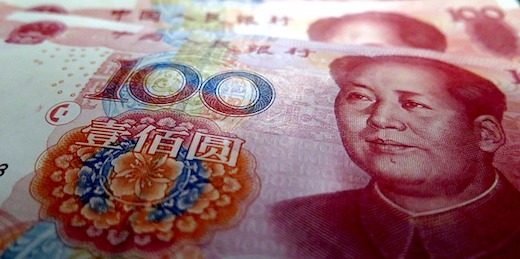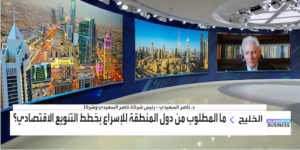The article titled “Why the GCC should adopt the PetroYuan”, appeared in The National on 9th Jan, 2018 and is posted below. Click here to access the original article.
Why the GCC should adopt the petroyuan
The entry of China into the World Trade Organisation in 2000 heralded a tectonic shift in world economic activity towards emerging markets and developing economies, whose share of world GDP jumped from 43 per cent in 2010 to 59.4 per cent in 2017 (based on puchasing power parity). Conversely, the share of advanced economies dropped sharply from 57 per cent to 40.6 per cent over the same period.
China’s share of global GDP is now 18.8 per cent (based on PPP), eclipsing the US (at 15.1 per cent) as the world’s largest economy. As the Asian emerging economies grew, so did their demand for oil, with lower prices since 2014 further increasing demand. Chinese oil demand growth accelerated to some 540,000 bpd in 2017 from 310,000 bpd in 2016, according to the International Energy Agency.
As the world’s top oil buyer and energy consumer, China has also built up strategic petroleum reserves of about 850 million barrels since 2015, at an average price of US$50. The result is that the market for GCC oil and gas has been subject to a dramatic shift in the past 15 years; Asia and China have replaced the US and Europe as their main export markets. Links between the GCC and Asia and China have also evolved beyond just the initial oil dependency. By 2020, it is projected that China will be the biggest export market for the GCC (about $160 billion), while GCC imports from China are projected to double in value (about $135bn).
Global financial architecture changes and Redback emergence
Given its size and growth prospects, China will dominate energy markets – both fossil fuel and renewable energy – in the coming decades. The country currently dominates world trade, being the largest exporter of goods since 2009. Its ambitious One Belt-One Road initiative will increasingly integrate countries into its economy and its global value chains.
Similarly, the establishment of the New Development Bank (formerly know as the Brics Development Bank), focusing on financing sustainable infrastructure development, and the Asian Infrastructure Investment Bank (AIIB), in which all the GCC countries are investors, mark the delayed transfer of “soft” power from the West to Asia and to emerging economies, confirming the shift in economic and financial weight. We are witnessing no less than the new building blocks of a changing global financial architecture.
The second major building block will be the creation of a Yuan Zone and the Redback Market. The Chinese yuan is now recognised as an international currency: in October 2016, it became the fifth currency in the basket constituting the IMF’s Special Drawing Rights, and is the world’s fifth most active for international payments.
China has taken multiple steps to internationalise the yuan, including some 32 currency swap agreements with central banks with a combined value of 3.33 trillion yuan (Dh1.85tn), as well as swap agreements with Egypt (18bn yuan), Qatar (35bn yuan) and the UAE (35bn yuan). The swap agreements are an instrument to finance and facilitate trade and issuance of debt and equity in yuan in foreign markets.
Capital market liberalisation is proceeding through the implementation of the Qualified Foreign Institutional Investor Scheme and RMB Qualified Foreign Institutional Investor Scheme, which allows designated institutional investors into yuan-denominated domestic markets. The planned relaxation of capital controls will be the next policy step to allow the use of the yuan to finance investment.
The path of yuan internationalisation starts with its use for financing trade with China, to investment in China’s financial markets, to the yuan being used as a store of value and as an international reserve currency. For the yuan to become a truly international means of payment, an asset currency and alternative to the US dollar and the euro, China needs to gradually move to full capital account convertibility, provide access to foreign issuers and investors, remove internal distortions (notably through interest rate liberalisation), achieve greater exchange rate flexibility and deepen its financial markets through the development of yuan money market instruments and debt capital markets, the Redback Market. This is part of China’s strategy.
The petroyuan will be used to finance China’s oil and gas
Given China‘s dominant role in world trade, the yuan will increasingly be used to finance trade with China, in particular along One Belt- One Road, and including energy and oil. The petroyuan will signal the gradual emergence of the yuan to become the world’s second most important currency, gaining market share from the dollar and the euro.
China has recently announced the establishment of a yuan-rouble payment system, hinting that similar systems will also be in place in the near future. Pakistan’s central bank has announced that public and private sector enterprises may use the yuan for bilateral trade and investment.
Russia is the largest exporter of oil to China; given the latest US sanctions, it is highly likely that China will introduce a crude contract priced in yuan. Oil exporters, including Russia, Iraq, and Indonesia, have accepted the yuan as payment for crude oil shipments. The next step is to establish traded yuan oil contracts, an innovation that would strongly reinforce the growing internationalisation of the yuan.
The GCC should adopt the petroyuan
Currently, GCC oil sold to China is priced and settled in the US dollars, through dollar-regulated clearing banks. This is an inefficient process, in that it increases transactions costs and involves exchange rate and payment risk. In addition, participants in the dollar-based payment system have also been subject to fines and penalties arising from politically motivated US sanctions. Given China’s dominance of GCC energy export markets, it is advantageous for both parties to price oil and gas and settle in yuan instead.
Chinese banks (which are the top four biggest global banks in terms of assets) and GCC banks –supported by the currency swap arrangements – can efficiently finance China-GCC trade, including oil. It is in the strategic interest of the GCC to be part of the growing yuan zone, use petroyuan for China oil trade, be active in the AIIB and integrate into the New Silk Road and the One Belt-One Road initiative.





